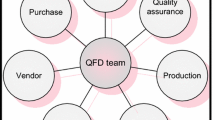Abstract
One drawback of current machinability data systems is the inability to accommodate technological changes. Existing schemes to optimise machinability data are too specific and rigid. This paper describes the development of a methodology for a more effective selection of machinability data. The methodology incorporates various techniques, such as expert systems and mathematical programming. The unique feature of this system is the way machinability data are handled to arrive at the most suitable solution. The system accepts a wide range of data, from the very complete and specific to the very general. The more detailed and specific the data set is, the more credible the results will be. The machinability data in the data banks are easily updated and improved using feedback data from current shop floor production. The process of obtaining solutions from these banks is regarded as flexible optimisation. This paper reports on the optimisation methodology for multipass turning operations. Longitudinal turning, facing, taper turning and contour turning have been considered.
Similar content being viewed by others
Abbreviations
- D :
-
diameter of component
- D i−1 :
-
workpiece diameter before theith pass
- D 0 :
-
initial workpiece diameter
- D m :
-
workpiece diameter at themth (last) pass of the roughing operation
- D L :
-
final diameter of workpiece
- K :
-
constant in the tool life relationshhip
- L :
-
length of cut
- P :
-
power
- R a :
-
centre-line-average roughness
- T :
-
tool life
- T F :
-
time for the finishing operation per component
- T R :
-
time for the roughing operation per component
- T T :
-
total production time per component
- x :
-
vector of variables equal (x 1,x 2, ...,x n)T
- d :
-
depth of cut
- d j :
-
depth of cut of thejth pass
- f :
-
feed
- f(x):
-
objective function to be minimised with respect tox
- g(x):
-
vector of constraint function
- g j(x):
-
jth constraint function written
- n :
-
exponent of cutting speed in the tool life relationship
- n 1 :
-
exponent of feed in the tool life relationship
- n 2 :
-
exponent of depth of cut in the tool life relationship
- n j :
-
machining parameter
- m :
-
number of passes
- t c :
-
cutting time
- t p :
-
preparation time
- t r :
-
tool replacement time
- t s :
-
tool reset time per pass
- v :
-
cutting speed
- x j :
-
machining parameter (or variable)
- x l :
-
lower bound onx
- x u :
-
upper bound onx
- ℛn :
-
n-dimensional real space
- R :
-
roughing operation (subscript only)
- F :
-
finishing operation (subscript only)
- l :
-
integer (subscript only)
- *:
-
denote values of quantities at minimising point (superscript only)
References
P. Balakrishnan and M. F. DeVries, “A review of computerised machinability data base systems”,Proceedings of NAMRC-X, Hamilton, Canada, pp. 348–356, May 1982.
S. B.Elwell and T. J.Jardine, “A machinability model expert system prototype”,Proceedings of CAM-I 13th Annual Meeting and Technical Conference, Clearwater Beach, Florida, USA, pp. 29–35, 1984.
H.-P. Wang and R. A. Wysk, “An expert system for machining data selection”,Computing and Industrial Engineering 10(2), pp. 99–107, 1986.
R. H. Philipson and A. Ravindran, “Application of mathematical programming to metal cutting”,Mathematical Programming Study 11, pp. 116–134, October 1979.
D. S. Ermer and S. Kromodihardjo, “Optimization of multipass turning with constraints”,Journal of Engineering for Industry 103(4), pp. 462–468, 1981.
J. A. Arsecularatne, S. Hinduja and G. Barrow, “Optimum cutting conditions for turned components”,Proceedings of the Institution of Mechanical Engineers, Part B: Journal of Engineering Manufacture 206, pp. 15–31, 1992.
B. K. Lambert and A. G. Walvekar, “Optimization of multipass machining operations”,International Journal of Production Research 16(4), pp. 259–265, 1978.
I. Yellowley, “A fundamental examination of the economics of the two-pass turning operation”,International Journal of Production Research 21(5), pp. 617–626, 1983.
S. K. Goyal, “The economics of two-pass machining operations”,Engineering Costs and Production Economics 8(4), pp. 263–267, 1985.
A. M. Abuelnage and M. A. El-Dardiry, “Optimization methods for metal cutting”,International Journal of Machine Tool Design Research 24(1), pp. 11–18, 1984.
S. H. Yeo, Y. S. Wong and M. Rahman, “Knowledge-based systems in the machining domain”,International Journal of Advanced Manufacturing Technology 6(1), pp. 35–44, 1991.
S. H. Yeo, M. Rahman and Y. S. Wong, “Towards enhancement of machinability data by multiple regression”,Journal of Mechanical Working Technology 10(1), pp. 85–99, 1989.
K. Taraman, “Multi machining output-multi independent variable turning research by response surface methodology”,International Journal of Production Research 12(2), pp. 233–245, 1974.
Krupp Widia,Recommended Data for Turning Ferrous Materials, no. W5.3-10.3 e 486, Krupp Widia GMBH, Germany.
SAS Institute Inc.SAS User's Guide: Statistics, Version 5 edn, SAS Institute Inc. NC, 1985.
Okuma Corporation,Programming Manual, 10th edn, Japan, 3277-E-R2, June 1991.
E. J. A. Armarego and R. H. Brown,Machining of Metals Prentice-Hall, NJ, 1969.
J. W. Lee, “A study on the determination of actual cutting time in NC turning”,International Journal of Production Research 26(9), pp. 1547–1559, 1988.
P. Y. Papalambros and D. J. Wilde,Principles of Optimal Design: Modeling and Computation, Cambridge University Press, 1988.
K. Schittkowski, “NLPQL: A FORTRAN subroutine solving constrained non-linear programming problem”, in C. L. Monma (ed.),Annals of Operations Research vol. 5, pp. 485–500, 1986.
M. J. D. Powell, “A fast algorithm for nonlinearly constrained optimization calculations”, inNumerical Analysis Proceedings, Dundee 1977, Lecture Notes in Mathematics (G. A. Watson ed.), Springer-Verlag, Germany, vol. 183, pp. 144–157, 1978.
Author information
Authors and Affiliations
Rights and permissions
About this article
Cite this article
Yeo, S.H., Rahman, M. & Wong, Y.S. A tandem approach to selection of machinability data. Int J Adv Manuf Technol 10, 79–86 (1995). https://doi.org/10.1007/BF01179275
Issue Date:
DOI: https://doi.org/10.1007/BF01179275




